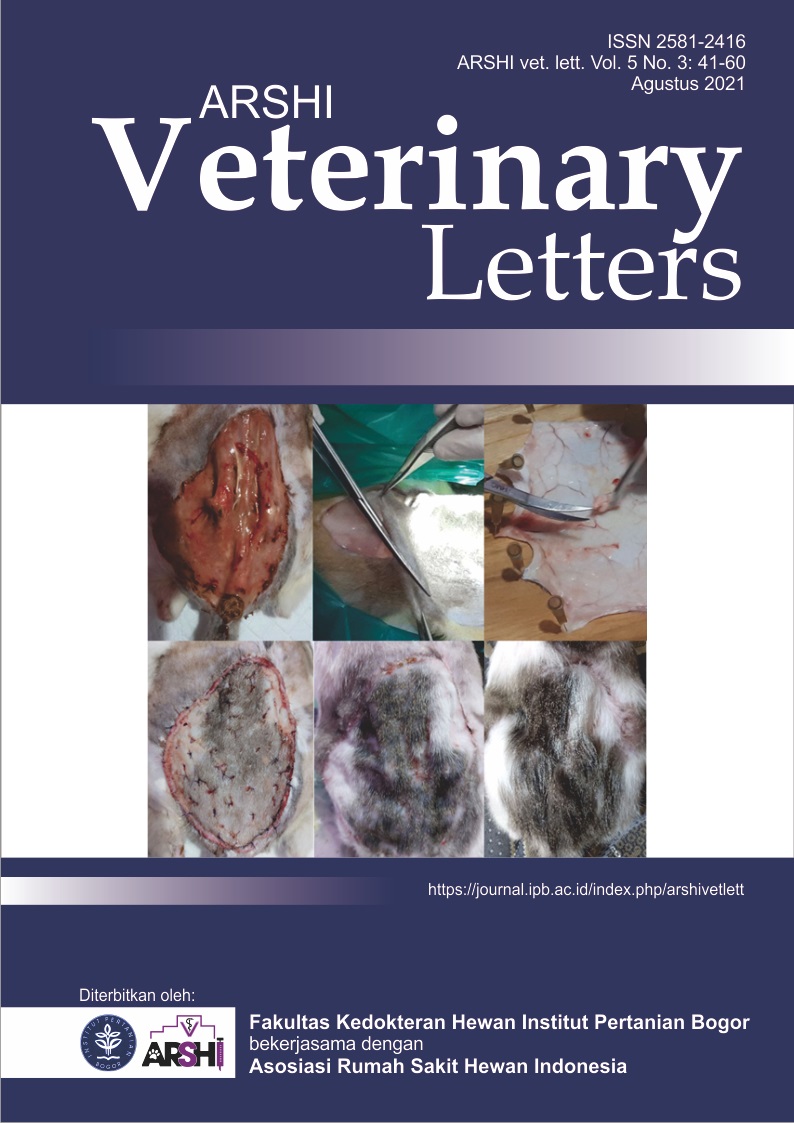Antimicrobial sensitivity of most commonly isolated bacteria from feline upper respiratory infection
Abstract
In cats, upper respiratory tract infection (URI) can be associated with primary or secondary bacterial infection and is generally treated with antimicrobials. Antimicrobial use can be inappropriate, and overuse. There are no detailed protocols for treatment, such as those available for human treatment. This study aimed to determine the antimicrobial sensitivity of the most isolated bacteria in cats that infected with the URI. Isolation and identification of bacteria in samples of cats infected with the URI were then continued with the antibiotic sensitivity test for amoxicillin, doxycycline, tetracycline, azithromycin, ciprofloxacin, and cefotaxime using the Kirby Bauer Agar Disc diffusion method. Based on the research results, the bacteria identified were Enterobacter spp, Streptococcus spp, Staphylococcus spp, Pseudomonas spp, Serratia spp, Yersinia spp, Micrococcus spp, Klebsiella spp and Hafnia spp. Amoxicillin antibiotic resistance was found in four isolates of Staphylococcus spp and two isolates resistant to cefotaxime. Amoxicillin and tetracycline antibiotic resistance were found in one isolate of Streptococcus spp, two isolates resistant to cefotaxime and two intermediate isolates to doxycycline. One isolate of Enterobacter spp was resistant to amoxicillin, azithromycin and two isolates were resistant to cefotaxime. All tested isolates were sensitive to ciprofloxacin. Based on the antibiotic sensitivity test, most isolates were sensitive, but there were isolates resistant to antibiotics, especially amoxicillin and cefotaxime.
Downloads
References
Andrews JM. 2009. BSAC standardized disc susceptibility testing method (version 8). Journal of antimicrobial chemotherapy. 64(3):454-489.
[ADICQC] Antibiotic Disc Interpretative Criteria and Quality Control. 2017. Italy (IT): Liofilchem. [Internet]. [Accessed at 2021 Mar 1]. http://www.liofilchem.net/pdf/disc/disc_interpretative_table.pdf
Barry AL, Fuchs PC. 1996. Surrogate disks for predicting cefotaxime and ceftriaxone susceptibilities of Streptococcus pneumoniae. Journal of clinical microbiology. 34(10):2609-2612.
[CLSI] Clinical and Laboratory Standards Institute. 2018. Performance Standards for Antimicrobial Susceptibility Testing. 28th ed. Wayne (USA).
Direct RX. 2015. Amoxicillin- Amoxicillin Tablet, Film Coated Tablet. [Internet]. [Accessed at 2021 Mar 1]. https://dailymed.nlm.nih.gov/dailymed/fda/fdaDrugXsl.cfm?setid=9179bb1b-8554-4c00-a323-aac951ae2f55&type=display
Parnham MJ, Haber VE, Giamarellos-Bourboulis EJ, Perletti G, Verleden GM, Vos R. 2014. Azithromycin: mechanisms of action and their relevance for clinical applications. Pharmacology & therapeutics. 143(2):225-245.
Foster TJ. 2017. Antibiotic resistance in Staphylococcus aureus. Current status and future prospects. FEMS microbiology reviews. 41(3):430-449.
Weese JS, Giguère S, Guardabassi L, Morley PS, Papich M, Ricciuto DR, Sykes JE. 2015. ACVIM consensus statement on therapeutic antimicrobial use in animals and antimicrobial resistance. Journal of Veterinary Internal Medicine. 29(2):487-498.
Yao Q, Gao L, Xu T, Chen Y, Yang X, Han M, He X, Li C, Zhou R, Yang Y. 2019. Amoxicillin administration regimen and resistance mechanisms of staphylococcus aureus established in tissue cage infection model. Frontiers in microbiology. 10:1638.
Copyright (c) 2021 CC-BY-SA

This work is licensed under a Creative Commons Attribution-ShareAlike 4.0 International License.
Authors who publish with this journal agree to the following terms:
1. Authors retain copyright and grant the journal right of first publication with the work simultaneously licensed under a Creative Commons Attribution License that allows others to share the work with an acknowledgement of the work's authorship and initial publication in this journal.
2. Authors are able to enter into separate, additional contractual arrangements for the non-exclusive distribution of the journal's published version of the work (e.g., post it to an institutional repository or publish it in a book), with an acknowledgement of its initial publication in this journal.
3. Authors are permitted and encouraged to post their work online (e.g., in institutional repositories or on their website) prior to and during the submission process, as it can lead to productive exchanges, as well as earlier and greater citation of published work (See The Effect of Open Access).


.jpg)















